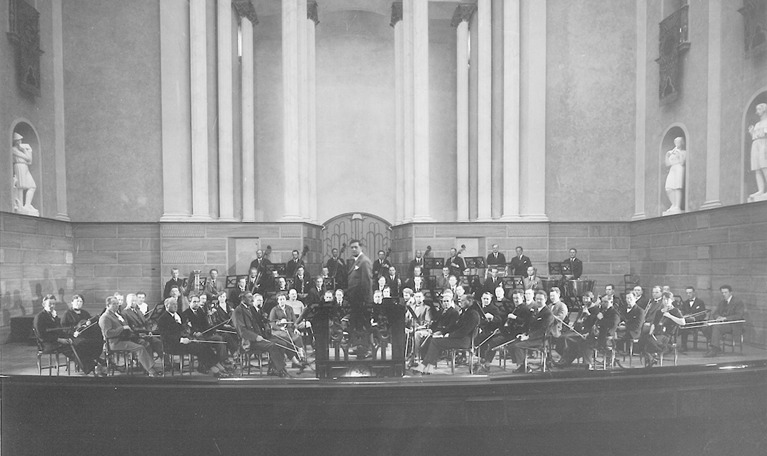Václav Talich

Václav Talich and the orchestra in 1926, the year he began his tenure.
Václav Talich was chief conductor from 1926–36. He conducted a total of 259 concerts with the orchestra.
Czech conductor Václav Talich (1883–1961) was primarily active in what was then known as Czechoslovakia. He was chief opera administrator and conductor in Plzeň from 1912–1915, and chief conductor of the Czech Philharmonic in Prague from 1919–1941 and 1947–1948. He was also a professor of conducting at the conservatory in Prague from 1932–1945 and conductor of the philharmonic in Bratislava from 1949–1952.
But in between, from 1926–1936, he was chief conductor of the Stockholm Concert Society in Stockholm. Talich was appointed chief conductor after only one concert production together with the orchestra (two performances in February 1926). During the years between his predecessor, Schnéevoigt, and Talich, it was primarily Adolf Wiklund who led the orchestra. For a short period, the 1925–26 season, German Wilhelm Sieben was active as the new chief conductor, but he left the orchestra during the season.
April 1926 saw the inauguration of the brand new Konserthuset, designed by Ivar Tengbom, and a cooperation agreement was drawn up between the new Stockholm Konserthuset Foundation and the Stockholm Concert Society.
During the first regular concert season in the new building, 1926–27, the orchestra gave 76 performances (70 concerts per season was typical in these years) and 26 of them were led by the new chief conductor, Václav Talich – including one Beethoven cycle and Mahler’s Symphony No. 9. Adolf Wiklund also conducted many concerts, and the orchestra welcomed guests such as Max Fiedler and Hilding Rosenberg.
Konserthuset was built not only with the orchestra in mind, but also the Nobel Prize Award Ceremony, which had been held in the Swedish Academy of Music’s main hall until that point. The first ceremony in Konserthuset was held on 10 December 1926.
Talich also eventually conducted some Swedish music, such as Berwald, Tor Aulin and Stenhammar in the 1927–28 season. In the following seasons, Talich generally conducted 25–30 concerts annually, with Adolf Wiklund as second conductor. During his time with the orchestra, Václav Talich conducted approximately 250 concerts! Also noteworthy are guest conductors such as Bruno Walter, who conducted Mahler’s Symphony No. 1 in Konserthuset in October 1930.
Fritz Busch, later chief conductor himself (Talich’s successor), debuted with the orchestra in 1932. Other noteworthy guest conductor appearances from these years include Eugen Jochum and Arturo Toscanini’s concerts in late 1933 – the latter of which were regarded as perhaps the most important for the orchestra to date. Toscanini also conducted a guest performance in Copenhagen that winter.
Béla Bartók’s guest performance as soloist in his second piano concerto in the spring of 1934 was one of the major events, along with Hermann Scherchen’s interpretation of Arnold Schoenberg’s Pelléas and Mélisande.
In 1935, Fritz Busch was forced to cancel many of his performances due to illness. Adolf Wiklund led the orchestra with increasing frequency, and in the 1935–36 season, the Stockholm audience encountered conductors such as Georg Szell, Igor Stravinsky (a programme of his own music, including the violin concerto and the Firebird suite) and Serge Koussevitzky.
